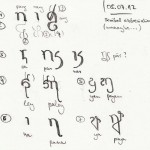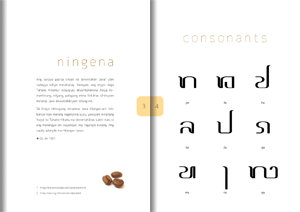Since I read about the Javanese script a couple of years ago, I’ve been kind of fascinated by the idea of its collation, formerly quoted on Omniglot, and – with better quotability – at the moment to be found in a paper by Michael Everson:
The traditional order of the Javanese script is: ha na ca ra ka da ta sa wa la pa dha ja ya nya ma ga ba tha nga and this order has some currency. (The order is hana caraka, data sawala, padha jayanya, maga bathanga, a sentence which means ‘There were (two) emissaries, they began to fight, their valour was equal, they both fell dead’.) (Everson 5)
I wondered whether something like this would also work for Ayeri, since it draws some inspiration from the phonologies of south-east Asian languages. Now fellow ZBB member Z500 posted a “Translation Challenge” today with a request to translate “The quick brown fox jumped [sic!] over the lazy dog,” the famous test sentence for fonts in Microsoft Windows, into one’s own language. I found the original example very unchallenging, so I finally wanted to tackle the attempt to make a pangram in Ayeri.
Since I’ve reworked this website last month, it is possible to simply enter a regular expression into the text field of the “Advanced Search” page, like this:
^([^aeiou(ay)(ey)(oy)(uy)āēīō]?a?)+$
Querying for this term returns a lengthy list of words that consist of the pattern C(a)C(a)… as in the Javanese example above. I chose to do it this way because using every vowel only once would’ve been extra hard, while there are numerous words that fit the Ca-pattern perfectly. So I played with this list a little, and came up with this:

[gloss]Ang kamayan para dagās vala, bahu ca!
AT be_as_as-3PM.T quick turtle-P lovely, shout-IMP 3PM.LOC[/gloss]
‘They are as quick as a lovely turtle; shout at them!’
or ‘If they are as quick as a lovely turtle, shout at them!’
However, this isn’t a perfect pangram: /u/ and /aː/ occur although I wanted all vowels to be just /a/, and also /j/ occurs twice, since c /t͡ʃ/ corresponds to ty in the ‘native’ script (see “Alphabet” page). The latter issue is debatable, however, since ya is a diacritic there (ya eyra), not the letter ya itself. Due to the sentence beginning with the particle ang this almost-pangram even includes the otherwise silent vowel carrier character, ranyan.
With currently 370 unique results for the word pattern quoted above, it will certainly be possible to make up more pangrams with some patience. Maybe I’ll give this another try sometime else and that time really manage to come up with a pangram the way I intended to make one.
- Everson, Michael. “Proposal for Encoding the Javanese Script in the UCS.” Evertype. 2011. Michael Everson, 28 Jan. 2008. Web. 29 Mar. 2011.
- “Javanese.” Ancient Scripts. Lawrence Lo, 2010. Web. 29 Mar. 2011.
- “Javanese Alphabet.” Omniglot. Writing Systems and Languages of the World. Simon Ager, 2011. Web. 7 Apr. 2010. (Access with ‹waybackmachine.org› on 29 Mar. 2011)
- Added interlinear formatting and rendition in native script.
- Another attempt at making a pangram in Ayeri.
 I’ve been reworking my font of Tahano Hikamu since February now and also drew a hinyan version (“Tahano Hikamu Java”) completely from scratch. When I felt like toying around with these things again a couple of weeks ago, I started making the files functional with Graphite – that is, I added ways to handle diacritics and I’m currently working on getting dynamic diacritic replacement and character reordering right – this is so much easier and far less brain-twisting with pen and paper!
I’ve been reworking my font of Tahano Hikamu since February now and also drew a hinyan version (“Tahano Hikamu Java”) completely from scratch. When I felt like toying around with these things again a couple of weeks ago, I started making the files functional with Graphite – that is, I added ways to handle diacritics and I’m currently working on getting dynamic diacritic replacement and character reordering right – this is so much easier and far less brain-twisting with pen and paper!

![Background: “光绪皇帝大婚图.” [“Picture of the Wedding of Emperor Guangxu.”] Wikimedia Commons. (Published in the Public Domain; cropped and label added)](/wp-content/uploads/2012/02/imperial-messages-title.jpg)

